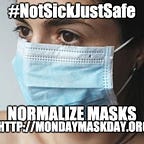Hidden COVID risk #1: “empty” elevators and the 1-hour rule.
The majority of Americans are wearing masks, but many of them are still getting sick. So there must be some hidden risks. That’s where the 1-hour rule comes in. Don’t take off your mask unless you know who has been in the room for 1-hour.
Why? Because COVID can linger for 1 hour.
CDC acknowledges this in Nov2020. "Smaller droplets and particles... can remain suspended for many minutes to hours and travel far from the source on air currents." https://www.cdc.gov/coronavirus/2019-ncov/more/scientific-brief-sars-cov-2.html
Before going into the rule, let me tell you two stories I’ve heard.
- Elevators. “Amy” and her boyfriend were at an elevator. Everyone walked out and then they walked in. Since they were “alone”, they took off their masks. After all, there was nobody to social distance from — Amy and her partner were alone, right?
- Break rooms. “John” is taking a coffee break and sitting alone in a room. Since John is alone, he takes off his mask. When “Kate” walks in to use the microwave, they both put their masks on. John leaves to go to the bathroom. Kate is “alone” and takes her mask off. John comes back, and the masks both go on. Kate finishes and leaves. John is “alone” and takes his mask off
These are everyday interactions and, before I read about COVID aerosols, I thought these were fine. After all, they don’t break the CDC’s guidance on masks and 6 feet. But, if you want to take aerosol risk seriously, follow the one hour rule.
COVID can linger for 1 hour.
We all know that asymptomatic and presymptomatic people can be spreading the virus. So, what if someone with COVID walks in an empty room, talks and sneezes for 10 minutes, and then leaves. You don’t know they did that, come in the empty room, and think, “I’m safe because I’m alone.” Or are you really safe?
It turns out that this is exactly the question answered by G.Buonanno, L.Stabile, and L.Morawska in their Aug 2020 paper Estimation of airborne viral emission: Quanta emission rate of SARS-CoV-2 for infection risk assessment
This is the key graph. The Y-axis is infection in the air or “risk”. The x-axis is time. You got to read the article to get all the details, but you can see how the risk is highest in the first 10 minutes (where it is blue and says “infected individual…”). The risk doesn’t go away for quite some time.
Technically, the risk isn’t just for 1 hour. But I’m using 1 hour as the headline; 1 hour is simple to remember. It’s still there until the ventilation clears it out. And that depends on the building. A stuffy building will take longer than a breezy building.
Another story: My friend “Lisa” went to a convenience store for some milk. She wore her mask the whole time. When she walked in, the checkout clerk wasn’t wearing a mask because they were alone. The clerk quickly put on their mask. When Lisa left, the friendly clerk said goodbye and took off their mask.
I get it. Masks aren’t comfortable and we don’t want to wear them if we don’t have to. But, if you care about hidden risk, especially if you have an older person or at-risk person at home, please use the 1 hour rule to stay safer.
The ghost analogy
A simple mental image is that COVID GHOSTS LINGER FOR 1 HOUR. Yes, you may be “alone”, but the ghost of an infected person will stick around for an hour. So, if you don’t know who was in the room for the last hour, keep your mask on. Better safe than sorry.
Hidden Situations for the 1 Hour Rule
- Employees in break rooms eating lunch.
If you need to eat, try to eat quickly, eat where there are fewer “ghosts” (crowds), or eat where the ventilation is good. I know some people who eat in their cars. - Empty bathrooms.
- Janitors cleaning “empty” offices.
- Teachers just after students leave the room.
In all of these situations, the advice is to keep your mask on if you can.
One exception to the 1-hour rule is if you are outdoors. That’s because of ventilation. A good way to think about it is to imagine a cigarette smoker. If someone was smoking a cigarette while they were in area, wait long enough for the smell to completely go away. Outdoors, that might just be 2 minutes. Indoors, it would be more like an hour. Faster if you open the windows.
Thanks to the following for sourcing the free-to-use images:
https://unsplash.com/@epicantus , solutioncanvas.com
https://unsplash.com/@sunearthmoonstudio, sunearthmoonstudio.com
https://unsplash.com/@mahadaamir, mahadaamir.com
https://unsplash.com/@stefanopollio, stefanopollio.com
